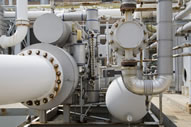
The largest uses of water in the United States include agricultural, industrial, and public supply (1). The following webpages highlight agricultural, industrial, and medical uses of water and their effects on human and animal health. Water quality is an important factor within these three areas. Some major factors that are important to consider in order to ensure adequate water quality include:
- Planning industrial sites, animal farms, barnyards, and feedlots effectively and efficiently,
- Decreasing microorganisms that are spread through water sources in hospital and medical facilities, and
- Decreasing the large amounts of heavy metals, solvents, toxic sludge, and other wastes that accumulate from industrial production.
Other Uses of Water Topics
- Agricultural
- Types,
- Contamination,
- Animal Feeding Operations,
- Resources...
- Medical
- Hydrotherapy tanks,
- Dialysis,
- Medical/Dental equipment...
- Industrial
- Freshwater quality,
- Cooling Towers,
- Legionnaire’s disease...
Other Uses of Water Fast Facts
- Each year between 8,000 and 18,000 people are hospitalized with Legionnaire’s disease in the United States (2).
- The Environmental Protection Agency (EPA) issues effluent guidelines and regulations that are technology-based and are developed for specific industrial categories (3).
- There are an estimated 238,000 Concentrated Animal Feeding Operations (CAFOs) in the United States that produce nearly 500 million tons of manure (4).
- The National Water Quality Inventory (2000) reported that agricultural nonpoint source (NPS) pollution (from industrial and sewage treatment plants) is the leading source of water quality impacts on rivers and lakes and the second largest source of impairment to wetlands. It is also a major contributor to contamination of surveyed estuaries and ground water (5).
- Most healthcare facilities follow certain guidelines to ensure that water is safe for medical use during medical procedures.
The Many Uses of Water

Water can be used for direct and indirect purposes. Direct purposes include bathing, drinking, and cooking, while examples of indirect purposes are the use of water in processing wood to make paper and in producing steel for automobiles. The bulk of the world’s water use is for agriculture, industry, and electricity. The most common water uses include:
- Drinking and Household Needs
- Recreation
- Industry and Commerce
- Agriculture
- Thermoelectricity/Energy
1. United States Geological Survey. Estimated Use of Water in the United States in 2000: Total Water Use. Available at http://pubs.usgs.gov/circ/2004/circ1268/htdocs/text-total.html.
2. Centers for Disease Control and Prevention. Legionellosis Resource Site: Patient Facts – Learn more about Legionnaires’ disease. Available at http://www.cdc.gov/legionella/patient_facts.htm.
3. Environmental Protection Agency (EPA). Effluent Limitation Guidelines. Available at http://www.epa.gov/guide/history.html.
4. Centers for Disease Control and Prevention. Concentrated Animal Feeding Operations (CAFOs). Available at http://www.cdc.gov/cafos/about.htm.
5. Environmental Protection Agency (EPA). Protecting Water Quality from Agricultural Runoff. March 2005.
![]() This icon indicates a link leading outside of this CDC Web site. While this external link provides additional information that is consistent with the intended purpose of the Centers for Disease Control and Prevention (CDC), not all external links will lead to federal websites. CDC cannot attest to the accuracy of a non-federal site, and linking to a non-federal site does not constitute an endorsement by CDC or any of its employees of the sponsors or the information and products presented on the site. You will be subject to the destination site’s privacy policy when you follow any link so indicated.
This icon indicates a link leading outside of this CDC Web site. While this external link provides additional information that is consistent with the intended purpose of the Centers for Disease Control and Prevention (CDC), not all external links will lead to federal websites. CDC cannot attest to the accuracy of a non-federal site, and linking to a non-federal site does not constitute an endorsement by CDC or any of its employees of the sponsors or the information and products presented on the site. You will be subject to the destination site’s privacy policy when you follow any link so indicated.
![]() Please note: Some of these publications are available for download only as *.pdf files. These files require Adobe Acrobat Reader in order to be viewed. Please review the information on downloading and using Acrobat Reader software.
Please note: Some of these publications are available for download only as *.pdf files. These files require Adobe Acrobat Reader in order to be viewed. Please review the information on downloading and using Acrobat Reader software.
Contact Us:
- Centers for Disease Control and Prevention
1600 Clifton Rd
Atlanta, GA 30333 - 800-CDC-INFO
(800-232-4636)
TTY: (888) 232-6348
24 Hours/Every Day - healthywater@cdc.gov


